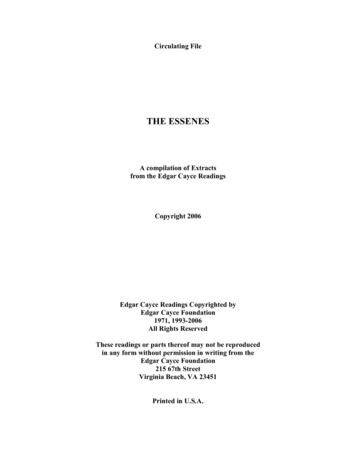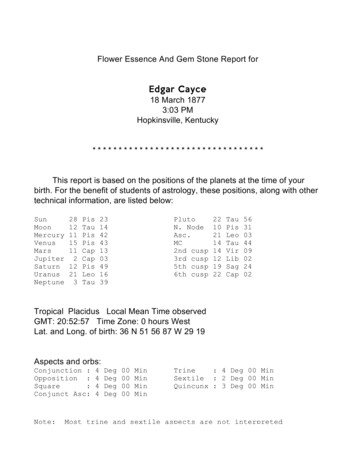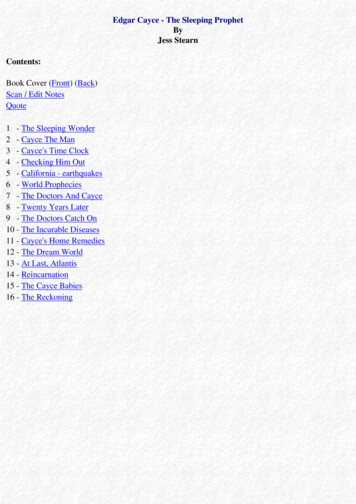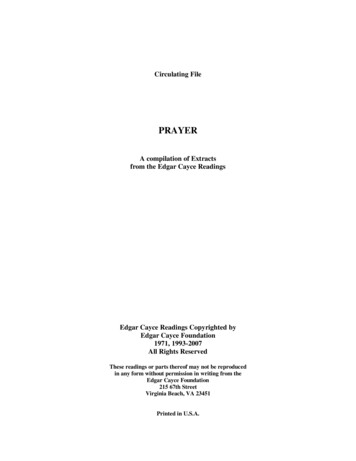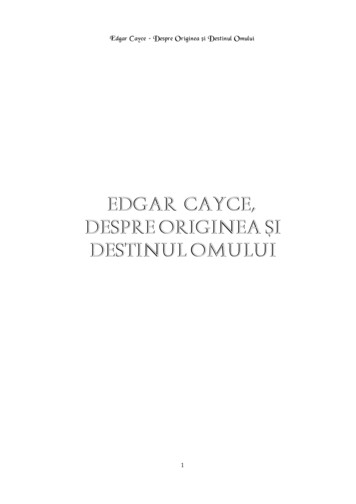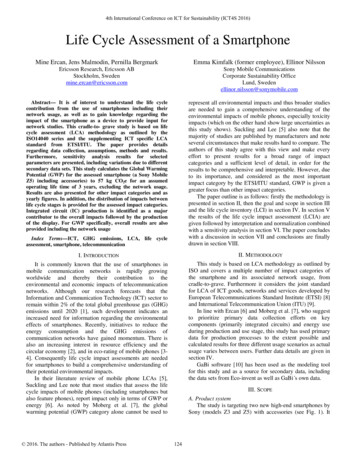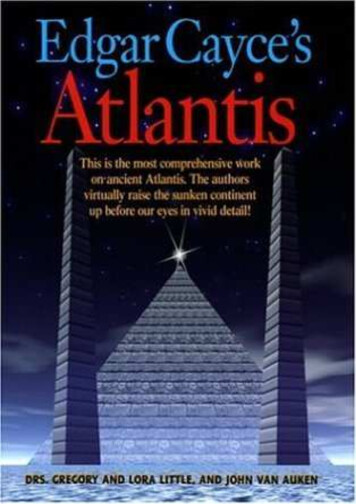
Transcription
THEATLANTISREADINGSEDGAR CAYCE
CHAPTER 13 “At Last, Atlantis”(From: Stearn, Jess - Edgar Cayce: “The Sleeping Prophet”)Just as man has gazed fascinated into the sea, atavistically peering into his past, sohas he engaged in a restless quest for Atlantis. In the ocean, said naturalist RachelCarson, he found from whence he had sprung, and in Atlantis, a dream of a superiorculture, prefacing the brief few thousand years of recorded history with which hemeasures his meager progress.Since Plato first described the Lost Continent of the Atlantic twenty-five hundredyears ago, more than two thousand books have been written about a legendary landthat nobody has seen. There have been books to prove Atlantis, books to disprove it.Some have been by erudite scientists, others by dreamers in search of a Shangri-La.While oceanographers, geologists, and ordinary sea-divers have been fanning outover the Atlantic for centuries in the underwater quest, Edgar Cayce merely wentto sleep, and saw visions of a magic continent which went through three periods ofbreakup, the last some eleven or twelve thousand years ago.Waking, Cayce didn’t know anything about lost continents and when his firstmention of Atlantis was called to his attention, he rubbed his eyes and said in thatgentle way of his,“Now I wonder where that came from, and if there’s anything to it?”At various times, Cayce’s Atlantis, just like Plato’s Atlantis, boasted a technicalculture, which eventually deteriorated to a point where the last denizens werevictims of their own destructiveness. Cayce’s readings on Atlantis, continuing for aspan of twenty years, were given before the first atom bomb was touched off,before it was known that man finally did have the power to blast himself back to theDark Ages, or turn the clock back to the Stone Age and life in a cave by bleakcampfire.Could it be that it had all happened before?“If we believe in evolution,” the Geologist pointed out, “then we must believe insome sort of superior society existing before our skimpy recorded history, sinceobviously we haven’t come very far since the time of Moses, Plato, Aristotle, orChrist.”There was an anthropological gap, from about seven thousand to thirty thousandyears ago, when anything could have been possible for all we know. Whole citiesand successions of cities had been buried before, as many different layers of Troyrevealed—so why not a whole country or continent? From magnetic grains, fromfossil remains, from layers of earth crust, we know the earth goes back millions ofyears, and yet we have no certain knowledge of what happened only yesterday,geologically.Had some cataclysm, destroying most or nearly all of humanity, also destroyed therecords of that humanity?And could it not happen again, at presumably any time, now that man had theweapons of his own destruction at hand?2
Or perhaps the tilt of the global axis, sending billions of tons of melting glacial icedown on us from the Pole, would suffice?Cayce’s and Plato’s Atlantis corresponded in many details, though Cayce had neverread the two dialogues, in which the greatest mind of antiquity passed on the storyof the island empire beyond the Pillars of Hercules.Cayce had seen three periods of destruction, the first two about 15,600 B.C., whenthe mainland was divided into islands, and the last about 10,000 B.C., when a groupof three large islands, along with some lesser, were swallowed up overnight, as Platohad suggested. Though the precise outlines of Atlantis, before its breakup into theislands mentioned by Plato, were never given in a Cayce reading, he indicated that itextended from what is now the Sargasso Sea area in the west to the Azores in theeast, and compared its size to “that of Europe, including Asia in Europe; not Asia,but Asia in Europe.”Before the last holocaust, waves of Atlanteans had, according to Cayce, dispersed inall directions, accounting for the superior, and often strangely familiar cultures, insuch diverse areas as Egypt, Peru, Mexico, Central America, and in our New Mexicoand Colorado, where they presumably became a colony of mound-dwellers.Before the final breakup, which centered near the Bahamas, the culture of thissuperior people, eroded by greed and lust, had disintegrated to a point, Cayce said,where their destruction, like that of Sodom and Gomorrah after them, wasinevitable.Cayce even gives us a picture of the destruction, which Plato doesn’t.“With the continued disregard of those that were keeping all those laws as applicableto the Sons of God, man brought in the destructive forces that combined with thosenatural resources of the gases, of the electrical forces, that made the first of theeruptions that awoke from the depth of the slow-cooling earth, and that portion nownear what would be termed the Sargasso Sea first went into the depths.”Cayce says cryptically that archives dealing with the existence of Atlantis,concealed in three areas of the world, will eventually be revealed: one of these areasis Egypt, where the ancient Egyptian priests assured the Greek lawmaker Solon, thesource of the Plato tale, that they had the account fully preserved.Of course, since Plato’s story has been discounted through the centuries, even hisreference to a continent—clearly North America—beyond the Atlantean islands beingdisregarded as part of an allegorical myth, it is hardly likely that the same breed ofhistorians and scientists would heed an unlettered clairvoyant dipping into hissubconscious to elaborate on one of the most engrossing tales ever told.Even the Geologist, gradually committed to Cayce and his wonders, found it hard toswallow Atlantis at first. But after delving into the scientific research of others, hebegan his own research, taking him at one point to the waters around Bimini, whereCayce forecast that the first of the sunken remnants of Atlantis would dramaticallyreappear. As the Geologist investigated, the scientific evidence began piling up.If Cayce was right in his clairvoyant medical cures, why shouldn’t he be right about3
other things? The information was certainly coming out of the same bottle, so tospeak. Cayce had observed that the lowlands of the Continent of Atlantis, before thispresumed breakup into islands, paralleled the present Atlantic seaboard, and theGeologist pointed out that ocean troughs parallel to New England, seventy to ahundred miles at sea, showed from their ancient sedimentation that they had oncebeen above surface.And what of the mid-Atlantic submarine ridge, spectacularly rising in spots, as it mayonce have dropped?“Sedimentary material from a depth of two miles on the ridge, revealed the exclusivepresence of fresh water plants,” the Geologist noted, “evidence that this section ofthe ridge was once above sea level.”Curiously, as recently as 1966, there was some confirmation of a gently slopingplane extending into the North Atlantic, and scientists at the Oceanographic Instituteat Woods Hole, Massachusetts, theorized it was a likely abode of the earliest humansin this continental area some twenty thousand years ago. However, oriented as theywere, they visualized this slope as easternmost North America, not westernmostAtlantis.To some, the Azores, eight hundred miles due west of Portugal, represent theeastern marches of the last of the Atlantean islands. And they have been acting uplately, just as their counterparts may have once before.Recent activity in the nine islands of the Azores is a striking reflection of theinstability that may have dropped Atlantis in the Atlantic thousands of years ago.Quiet for centuries, the Azores began erupting in 1957, curiously close to the year1958, which Cayce saw as the forty-year beginning of large-scale breakups aroundthe globe.As perhaps with Atlantis, the 1957 quakes and volcanic eruptions created migratorywaves, as they broke up islands and destroyed thousands of homes. In February of1964, there was another four days of nightmare quakes, and thousands of refugeesfled the isle of Sao Jorge, hard hit by a thousand tremors.The ‘57 quake recalled early scenes described by Cayce. The Geologist picked up areport by one of the refugees, Bernadette Vieira, who with her family fled Sao Jorgeand settled in Santa Clara, California.Bernadette’s experience was most graphic:“She ran screaming down the village street as a volcanic island arose from the seabetween Sao Jorge and nearby Fayal Island.“On that day the earth shook, and stone-walled houses toppled. Hundreds of personswere killed. Hot ashes fell like rain. Crops were ruined, and livestock was killed.“The volcanic island sank back into the sea as quickly as it had risen.”In the ‘64 quake, panicky residents feared the tremors might activate two dormantvolcanoes on either tip of Sao Jorge.“The ground is trembling almost continuously,” a Portuguese news agency reported,“the people of Sao Jorge feel like shipwrecks on a raft.”4
In one community of thousands, only three houses were left standing. Telephoneand telegraph communications were cut. The air smoldered with sulphur fumes. Ahastily assembled flotilla carried doctors, ambulances and blood plasma to thestricken island in response to the SOS:“Important damages. Many ruins. Request all navigation available in proximityproceed southern coast this island render assistance.”There was more:“If the volcanoes erupt,” the Geologist read aloud, “they could split the island andcause it to crumple into the sea.”The Geologist brought out a map, showing how the Azores archipelago, strangelyscattered in mid-ocean, stretched for four hundred miles, with its chain of craggycoastlines, volcanic mountains, crystal-clear crater lakes and lush subtropicalvegetation. Whatever a mainland had in fresh water, fauna and flora, these islandssurrounded by seawater, also had, plus a legacy of volcanic instability.“Could it really be,” I asked, dubiously pointing to the loop of rocky isles, “that thiswas once Atlantis?”The Geologist shrugged.“Why not? What’s left is due west of the Pillars of Hercules, where Plato fixed theoriginal islands. Geologically, where any phenomenon occurs in the present, it alsooccurred in the past, as part of normal evolutionary change. All that had to vary wasthe degree of change. Instability is an obvious feature of that area.”The Azores have caught the fancy of even the Russians.“In 1963,” the Geologist pointed out, “a leading Russian geologist, Dr. MariaKlionova, reported to the Academy of Science of the USSR that rocks had beendredged up from depths of 6600 feet, sixty miles north of the Azores, which gaveevidence of having been exposed to the atmosphere at approximately 15,000 B.C. —just about the time Cayce fixed for the breakup of the Atlantean mainland.”Similar evidence had turned up long before.“In 1898,” the Geologist said solemnly, “the crew of a ship laying underwater cablenear the Azores was grappling for a line in water two miles deep. As the grapplinghooks scraped the ocean bottom, they turned up unfamiliar particles of lava, whichfrom its peculiar glassy structure could only have solidified in the open air.”Reflecting the instability of the ocean bed in this area, a British freighter reportedsighting a steaming volcanic island just south of the Azores before the turn of thecentury, but the island had disappeared before geologists could get back to it.On a smaller scale than Atlantis, land has dramatically vanished in various parts ofthe world.“In 1883,” the Geologist noted, “the island of Krakatoa, near Sumatra, blew up witha loss of thousands of lives. In 1916, Falcon Island, east of Australia, disappearedwithout a trace, reappeared in 1923, then disappeared in 1949.”The floor of the ocean often rears up violently.“After a 1960 earthquake had leveled the Moroccan town of Agadir,” the Geologistnoted, “soundings revealed that nine miles offshore the sea bottom had buckled up3300 feet in one great convulsive thrust.”In August 1923 the Western Union Company, searching for a displaced cable,discovered that the Atlantic floor had risen two miles at one point since the lastsoundings twenty-five years before.5
Cayce’s Atlantis broke up into five islands, the three largest being Poseidia, Aryan,and Og. His most striking prediction concerned Poseidia. For in June 1940, as notedby the Geologist, he made a forecast that should soon materialize, if he wasclairvoyantly on the beam.“And Poseidia,” he said, “will be among the first portions of Atlantis to rise again.Expect it in sixty-eight and sixty-nine [’68 and ‘69]. Not so far away.”And where to expect it? The Geologist had the clue in still another Cayce reading.“There are some protruding portions that must have at one time or another been aportion of this great Atlantean continent The British West Indies or the Bahamas,and a portion of the same that may be seen in the present, if a geological surveywould be made, notably in the Gulf Stream through this vicinity, these [portions]may yet be determined.”Eagerly the Geologist combed through scientific literature on the geology beneaththe Gulf Stream. Rather wide-eyed, he read of a submerged stream valley 2400 feetbelow the waves between Florida and the Bahamas, of giant sinkholes submergedsix hundred to nine hundred feet off the tip of Florida, of mysterious bumps pickedup by depth sounders in the Straits of Florida. The bumps appeared about the sizeof homes; only these “houses,” if they may be called that, are two thousand feetbelow on the ocean floor.Geology appeared to be getting ready for Atlantis.“Before Cayce’s death in 1945,” the Geologist said, “the scientific assumption wasthat the ocean basins were huge bathtubs into which detritus [debris fromdisintegrating rock] was sluiced for many eons. However, through a new instrument,a sub-bottom depth profiler, it has been discovered that in great areas, theaccumulation of sediment is remarkably small, especially on portions of the ridges,as would happen if there had been continen
(From: Stearn, Jess - Edgar Cayce: “The Sleeping Prophet”) Just as man has gazed fascinated into the sea, atavistically peering into his past, so has he engaged in a restless quest for Atlantis. In the ocean, said naturalist Rachel Carson, he found from whence he had sprung, and in Atlantis, a dream of a superior culture, prefacing the brief few thousand years of recorded history with .
